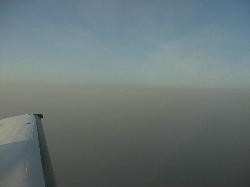Wed, Apr 21, 2010
NLR Research Aircraft Used To Verify Movement Of The Cloud
 The National Aerospace Laboratory's (NLR) research aircraft
has investigated the volcanic ash cloud hovering over the
Netherlands. The purpose of this flight was to verify the accuracy
of atmospheric models currently being used to predict the movements
of the ash cloud.
The National Aerospace Laboratory's (NLR) research aircraft
has investigated the volcanic ash cloud hovering over the
Netherlands. The purpose of this flight was to verify the accuracy
of atmospheric models currently being used to predict the movements
of the ash cloud.
From the flight undertaken by the Cessna Citation on Sunday
night above the Netherlands' southern provinces, it emerged that
the ash cloud is highly visible. The edges of the ash cloud
hovering above the country's southern provinces were also highly
visible, which is crucial information for pilots when the air space
is (temporarily) opened.
The objective of this flight was to verify the accuracy of the
models the Royal Netherlands Meteorological Institute uses to
calculate the movements of the volcanic ash cloud. These
measurements are then used by the Dutch aviation authorities to
take decisions regarding the closing and (re)opening of air
space.
Sunday night's flight revealed that the models had accurately
estimated the location of the volcanic ash layer. The NLR's
research aircraft flew over the ash cloud, which at the time was
hovering at a height of 1.8 miles and was comprised of varying
thicknesses.

NLR Photo
There are very few methods currently available in Europe for
precisely measuring and tracking volcanic ash. Moreover, there are
no set regulations in place for determining which ash particle
concentration levels necessitate the opening (or closing) of air
space. NLR researchers are therefore currently working closely with
other institutes, including the Royal Netherlands Meteorological
Institute, the National Institute for Public Health and the
Environment, the Dutch Ministry of Defence, the Ministry of
Transport, Public Works and Water Management, and Eurocontrol. This
joint research will determine the best methods for quickly and
safely launching sensors and measuring instruments capable of
accurately monitoring volcanic ash.
More News
Aero Linx: Model Aeronautical Association of Australia MAAA clubs are about fun flying, camaraderie and community. For over 75 years, the MAAA has been Australia’s largest fl>[...]
Touchdown Zone Lighting Two rows of transverse light bars located symmetrically about the runway centerline normally at 100 foot intervals. The basic system extends 3,000 feet alon>[...]
“Discovery and innovation are central to our mission at Virgin Galactic. We’re excited to build on our successful record of facilitating scientific experiments in subor>[...]
How To Get A Story On Aero-TV News/Feature Programming How do I submit a story idea or lead to Aero-TV? If you would like to submit a story idea or lead, please contact Jim Campbel>[...]
Student Pilot Reported That During Rotation, “All Of A Sudden The Back Of The Plane Kicked To The Right..." Analysis: The student pilot reported that during rotation, “>[...]
 ANN's Daily Aero-Linx (05.02.24)
ANN's Daily Aero-Linx (05.02.24) ANN's Daily Aero-Term (05.02.24): Touchdown Zone Lighting
ANN's Daily Aero-Term (05.02.24): Touchdown Zone Lighting Aero-News: Quote of the Day (05.02.24)
Aero-News: Quote of the Day (05.02.24) ANN FAQ: Contributing To Aero-TV
ANN FAQ: Contributing To Aero-TV NTSB Final Report: Cirrus Design Corp SR20
NTSB Final Report: Cirrus Design Corp SR20




